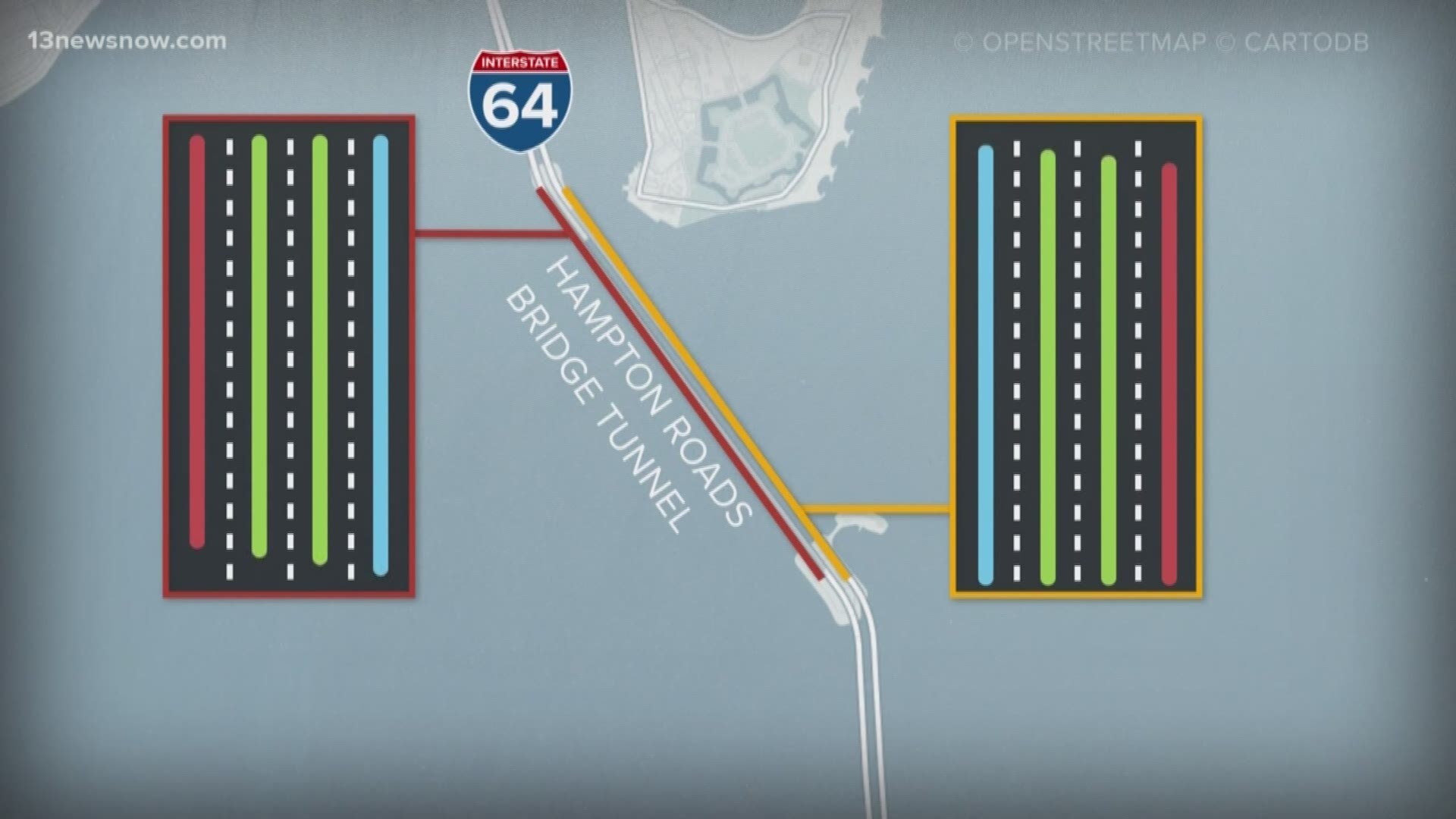NORFOLK, Va. — In the next year or two, the seabed between Hampton and Norfolk will start to change. Mud and sand will slowly move as a custom-built boring machine tunnels alongside the Hampton Roads Bridge-Tunnel.
Travelers funneling through the existing HRBT may not notice the adjacent construction just on the other side of the tunnel wall. Cargo ships and Navy vessels, carrying thousands of containers and sailors, may pass over the project’s construction completely undisturbed.
And that’s the way Hampton Roads Transportation Planning Organization officials want it to stay.
“It’s something we’re really proud of,” said Robert Crum, executive director for the Hampton Roads Transportation Planning Organization.
Totaling about $3.8 billion, the HRBT expansion project is the largest in the history of Virginia, and one of the largest currently in the country.
But the critical project — aimed at reducing chronic congestion both eastbound and westbound in the existing tunnels — also slips directly beneath one of the East Coast’s largest shipping and Naval channels.
Building an entirely new tunnel in an important United States port, the Port of Virginia, requires some preparation to avoid impacting the economy, tourism and national security.
“The port is becoming one of the most powerful ports on the East Coast,” Crum said. “It moves products and goods to much of the East Coast economy.”
Eventually, when the new tunnel is built — the project is still in the design phase — it will help increase traffic flow and reduce backups, boosting the regional and national economy by letting trucks and cars pass through quicker.
“We’re talking about a major congestion point, we believe,” Crum said. “Not only in Hampton Roads, but in the state.”
In February, the Virginia Department of Transportation announced it had awarded a contract to Hampton Roads Connector Partners, which would bore the tunnel.
The expansion is now fully funded, said Kevin Page, executive director for the Hampton Roads Transportation Accountability Commission, which handles funding for HRTPO projects.
Keeping ships moving
Overall, Crum said the HRBT expansion construction will have little impact on shipping and Naval crossings while construction is underway because contractors are using the tunnel-boring method instead of dredging.
“Kind of think of it as a mole in your backyard,” Page said. “You will not see an interruption in service… You’ll be coming and going and probably not even know it’s going on.”
While the Hampton Roads Connector Partners was chosen as the contractor to bore the new tunnel, Crum said the immersion tube method for building the tunnel was also on the table. The immersion method was used for the 10 other tunnels in Hampton Roads.
One contractor put in a bid for immersion tube construction, but withdrew their interest during the procurement process, Crum said.
The boring machine will be custom built for the HRBT project.
The HRTPO made a presentation to Williamsburg City Council June 10, discussing the progress of the organization’s various projects, including the HRBT expansion.
During the meeting, council members and HRTPO officials talked about the importance of the Port of Virginia and HRBT to the regional and national economy.
“From an economic vitality standpoint, the amount of traffic that comes through now, and will continue to come through and grow in future years, is critically important for the health of the commonwealth and the whole eastern seaboard,” Williamsburg Mayor Paul Freiling said.
Crum said cargo ships up to 18,000 TEU, or 20-foot equivalent units, come into the Port of Virginia. A TEU is the size of one shipping container.
“We need this project complete,” Crum said.
The setup
Design is still in the works, but Crum said it is currently leaning toward a 3-4-3 model, with a new, four-lane tube.
The new construction will add one full-time lane in each direction, as well as a “managed lane” similar to an HOV lane, but called an “HOT” lane, said Michael Kimbrel, deputy executive director of the HRTPO.
The HOT lanes will function in two ways: Cars with two passengers can ride the lane for free, while single drivers can ride in the lane for a toll.
The HOT lane toll will likely range from about 60 cents to $2, Crum said. The toll will change depending on how many vehicles are using the HOT lane.
The new tunnel would help crews work on the old tunnels, Kimbrel said, which were built in 1957.
“With this new project in place, that’ll provide capacity so they can close existing tubes to do work,” Kimbrel said.
Getting giant projects funded
Without a bill passing through the General Assembly, the HRBT expansion may never have been able to come to fruition.
Crum said the “pivotal moment” came in 2013 when the General Assembly passed House Bill 2313 which created a regional funding mechanism for Hampton Roads and Northern Virginia by increasing some gas and sales taxes and putting the money into a transportation fund.
That fund have helped funnel more than $5 billion into Hampton Roads transportation projects, including the expansion — $3.6 billion of the project is funneled through HRTAC, and about another $200,000 was awarded for the project from the state through the SmartScale program.
“For the first time, Hampton Roads had money to complete some much, much needed transportation improvement on the interstate highway system,” Crum said.
VDOT aims to complete the expansion by September 2025.

